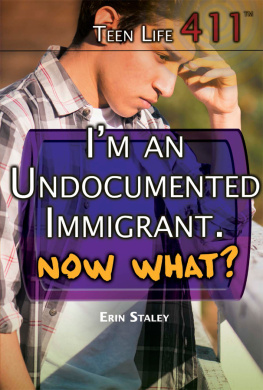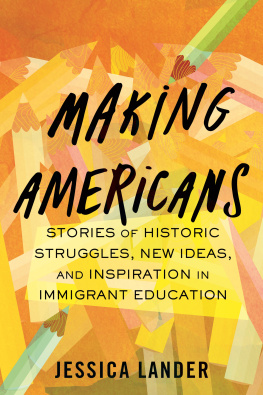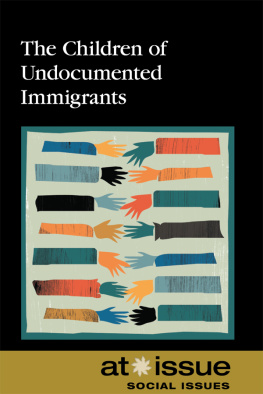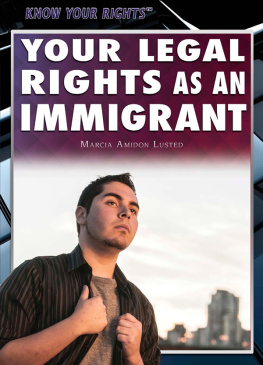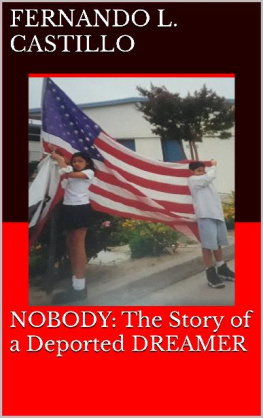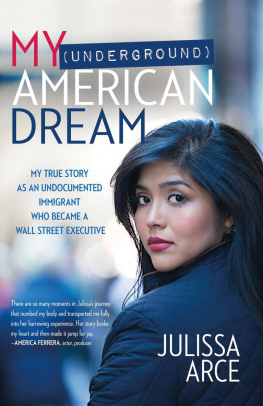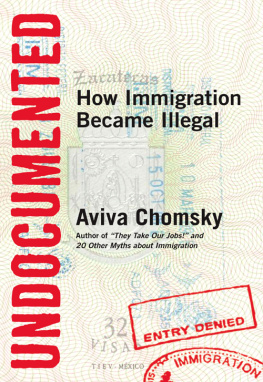Published in 2017 by The Rosen Publishing Group, Inc.
29 East 21st Street, New York, NY 10010
Copyright 2017 by The Rosen Publishing Group, Inc.
First Edition
All rights reserved. No part of this book may be reproduced in any form without permission in writing from the publisher, except by a reviewer.
Library of Congress Cataloging-in-Publication Data
Names: Staley, Erin.
Title: Im an undocumented immigrant. Now what? / Erin Staley.
Description: First edition. | New York : Rosen Publishing, 2017. | Series: Teen life 411 | Includes bibliographical references and index. |
Identifiers: LCCN 2016028548 | ISBN 9781508171935 (library bound)
Subjects: LCSH: Illegal aliensUnited StatesJuvenile literature. | Immigrant youthUnited StatesJuvenile literature. | United StatesEmigration and immigrationJuvenile literature.
Classification: LCC JV6483 .S65 2017 | DDC 305.235086/912dc23
LC record available at https://lccn.loc.gov/2016028548
Manufactured in Malaysia
I NTRODUCTION
A ccording to the Pew Research Center, there were 11.3 million unauthorized immigrants in the United States in 2014. They came in search of the American Dream, but live in fear of being discovered and deported because of their illegal status. An undocumented immigrant is one who is in a country without government permission. This person may have come to the country on a non immigrant visa and overstayed the expiration date. Or this person may have entered without inspection (EWI). This means that no interaction took place between that individual and a US Border official. Then there are those who are in the process of gaining permanent residence, but have yet to acquire their legal documentation.
Undocumented immigrants are commonly referred to as undocumented Americans. Children, tweens, and teenagers without legal status are often called undocumented youth or DREAMers. If they were foreign-born but live in the United States with a parent and a younger US-born sibling, they are considered to be a part of the 1.5 Generation. Terms that are insensitive and ought to be avoided include anchor baby, unauthorized, and illegal aliens.
Mary Tamer recognizes the undocumented youth population in The Education of Immigrant Children (2014):
Undocumented status affects more than 1 million children today, which is about one-third of all immigrant youth. Another 4.5 million US-born youth have an undocumented parent. Children face barriers because of their parents undocumented status, often related to poverty, fears of deportation, and more, while undocumented youth themselves face increasing barriers to social mobility as they enter adolescence and hope to obtain drivers licenses, afterschool work, and financial aid for college. Even when children themselves are unaware of their family members legal status, being undocumented or the child of an undocumented parent negatively impacts a childs development.
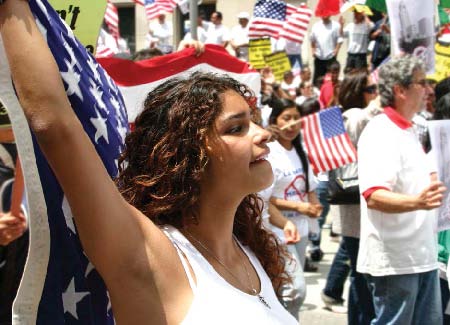
Immigrants from all over the world come to the United States. Some with adventurous spirits, seeking opportunity. Others who are fleeing political upheavel, religious oppression, or environmental disasters.
Being an undocumented American can be very lonely. You live in the shadows of being identified and deported, separated from everyone you love and everything you know. This fear could prevent you from getting involved and connecting with others. You may avoid playing sports, joining the debate team, going to the big dance, or meeting up with friends at a popular hangout. Mistrust, stress, anxiety, depression, and anger could result, further complicating your mental and physical well-being. But you are not alone. There is help within your community and on a national scale.
Advocacy groups, faith-based programs, educational institutes, and nonprofit organizations work to support, advise, and finance undocumented immigrants in their efforts to pursue an education, understand their rights, get a job, and seek legal status. Government policies and programs are in place to help you stay in the country, provided qualifications are met and maintained. And immigration attorneys are available to help navigate the nations complicated and lengthy immigration process. Many of these resources are detailed in this book, helping youor those you knowhave the peace of mind and the knowledge needed to create your American Dream.
CHAPTER 1
W HO A RE U NDOCUMENTED I MMIGRANTS ?
U ndocumented immigrants are those who have either entered or remained in the United States without legal documentation. Some are aware of their illegal status, and others are not. The American Psychological Association (APA) reports that there are 4.5 million US citizen children with unauthorized parents. Then there are another 1.5 million who are undocumented youths. No matter their circumstances, these youngsters live in fear. They live in the shadows, afraid of being discovered by government officials who could forcibly take them from loved ones, only to be dropped into the child welfare system, sent to detention centers, and deported to their country of origin. These fears bring on feelings of isolation, mistrust, stress, anxiety, depression, and anger.
G ROWING U P AS U NDOCUMENTED A MERICANS
The APAs video, Undocumented Americans, features the real-life stories of three undocumented youths: Jong-Min, Silvia, and Pedro. Each came to the United States at a young age, and has unique stories to share.
I always thought I was legal in a sense, says Korean-born Jong-Min, recalling how shocked he was to learn of his illegal status. He had felt American in every sort of way. His parents warned him not to reveal the familys status. They were afraid of deportation. Jong-Min soon recognized the limitations he faced. He wasnt able to do what his peers did. Being undocumented is like living in this invisible prison, he says. Im American, and this is my home. This is my country.
Pedro came to the United States as a four-year-old. He was heartbroken when he learned of his familys illegal status. I had to learn to be below the radar in everything I did, staying out of trouble, doing well in school, he says. And I was never outside of my home unless I had a good reason for it. Pedro credits his siblings for being good role models. He worked hard in school, and was later accepted to Cornell University. Pedro even received scholarships. However, the threat of deportation lingered. In 2008, while traveling from Chicago to Cornell University, his bus was stopped by a Border Patrol agent. The agent questioned each passenger. Pedro admitted that he wasnt a US citizen. The college student was arrested. He was fingerprinted, made to strip and wear an orange jumpsuit, and held in a federal marshals prison in New York. There was no one there that I felt was on my side. It was me versus everything, he says. I was fighting for my freedom to be in this country. Pedro was released after twentyfour hours.
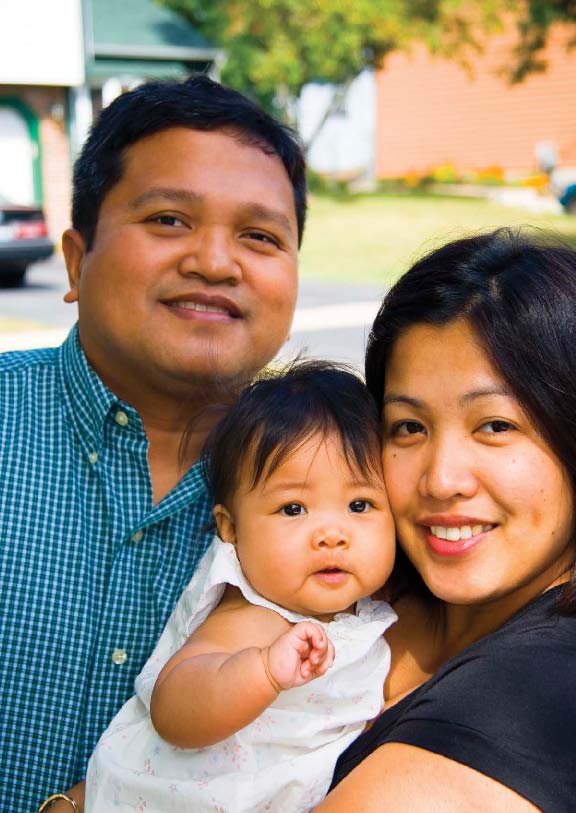
Many immigrants arrive in the United States at a time in their lives when they are considering starting a family. This can lead to separationand heartacheif proper documentation is not attained.

